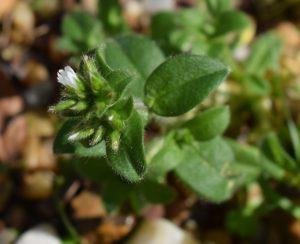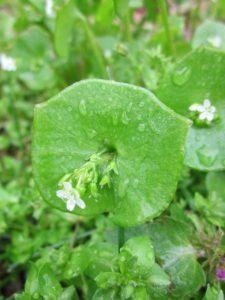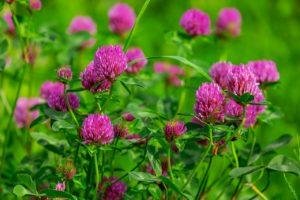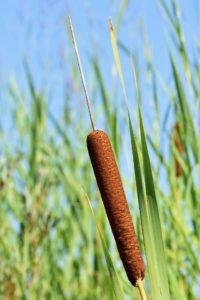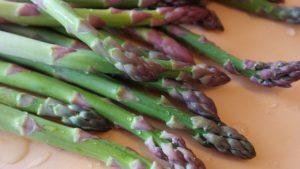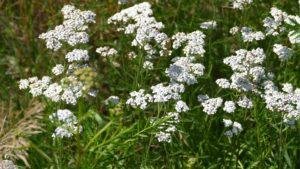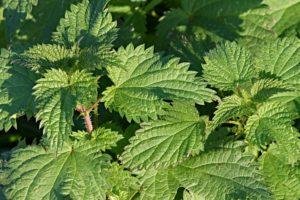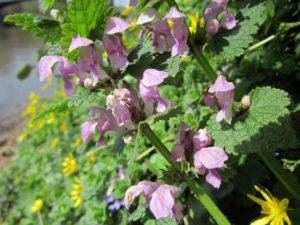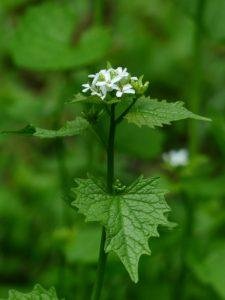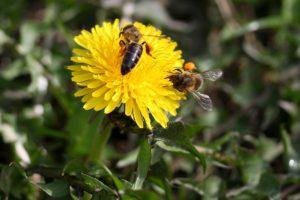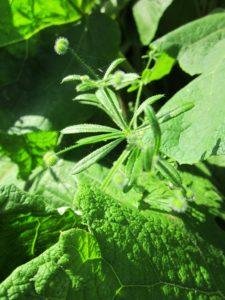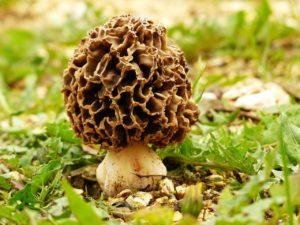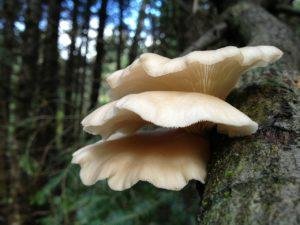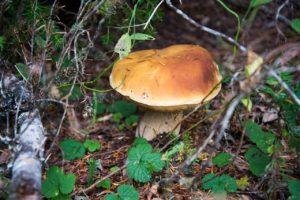Are you wondering what you can do outside in the early spring? Go foraging! It’s a great way to reconnect with nature after a long winter. Spring is the season of new beginnings and new growth and my favorite season.
As the temperature starts to warm up and everything begins to thaw from the winter, spring foraging options increase! This is the time of year for fresh salad greens, tasty spring flowers and shoots, medicinal plants and a few edible mushrooms.
What To Forage
Chickweed (Stellaria media) is one of the first spring weeds to appear. Chickweed grows in lawns, meadows, gardens and disturbed areas, in full sunlight and partial shade. Collect this plant where it’s thriving, young and bright green before it begins to go to seed.
Eaten raw, it tastes like corn-on-the-cob. Cooked, it tastes more like spinach. Always chop the entire plant, except the roots, into bite-sized pieces before using it. Young chickweed is used like sprouts in sandwiches or with hummus in a pita.
Chickweed has powerful anti-inflammatory compounds that help ease discomfort and pain. This is good for people who suffer from chronic inflammatory conditions, such as osteoarthritis or irritable bowel syndrome (IBS). An herbal salve is useful on rashes, bug bites, and dry or itchy skin.
Miner’s Lettuce (Claytonia perfoliata) was eaten by the California gold miners to prevent scurvy. This weed cleanses the body and provides energy for the liver and lymph system. It is eaten raw in salads and boiled like spinach. Miner’s lettuce has a mild, delicate flavor and makes a delicious addition to salads or sandwiches.
Be careful when gathering miner’s lettuce because it often grows near poison oak. The stems, cups, leaves, and flowers are all edible.
Red clover (Trifolium pratense) flowers contain many nutrients including calcium, chromium, magnesium, niacin, phosphorus, potassium, thiamine and vitamin C.
They’re a rich source of isoflavones. Isoflavones lower the loss of bone mineral density in menopausal and postmenopausal women. To reap clovers full benefit, drink as a tea or infusion.
Red clover contains estrogen-mimicking flavonoids known as phytoestrogens. Phytoestrogens contribute to maintaining normal estrogen levels during menopause. This is especially helpful in reducing hot flashes and night sweats. Drink a quart of clover infusion daily.
Red clover promotes the drainage of mucus from the lungs by thinning the mucus and lubricating an irritated respiratory tract. It also promotes the secretion of phlegm from the lower airway. It is useful in treating whooping cough, bronchitis, asthma, and colds. Because of its ability to calm bronchial spasms and improve sleep quality, it is an excellent herb to take before bedtime to alleviate coughing in one’s sleep.
Foraging In Damp Areas
Cattail (Typha latifolia) roots are edible raw or cooked. Boil and eat like potatoes or macerated and then boiled to yield sweet syrup. Young shoots are consumed in the spring raw or cooked. Young shoots are prepared like asparagus but require longer cooking time to make them tender. Add the roots to soups towards the end of cooking and they retain a refreshing crunchiness. They’re superb in stir-fry dishes and excellent in virtually any context.
Roots are dried, ground into a powder and used as a thickener in soups and stews.
The lower parts of the leaves can be used in a salad. The young flowers are roasted. Yellow pollen which appears mid-summer is added to pancakes for added nutrients. Shake the pollen into a paper bag and use it as a thickener in soups and stews or mix it with flour for some great tasting bread.
Cattail improves digestion as it consists of a good amount of soluble and insoluble fiber which is essential for improving the digestion process. Soluble fibers counter the absorption of cholesterol and insoluble fiber encourages the movement of waste out of the system. This leads to reduced chances of constipation or hemorrhoids.
Medicinally the jelly from between the young leaves has the ability to reduce pain, speed wound healing, prevent infections and slow bleeding. The jelly is a powerful analgesic and ingested or applied topically it relieves pain and inflammation.
Wild asparagus (Asparagus cochinchinensis) provides a wide variety of antioxidant nutrients, including vitamin C, beta-carotene, vitamin E, and the minerals zinc, manganese and selenium.
This plant helps stabilize digestion due to the high amount of fiber and protein that it contains. The fiber and protein help move food through the gut and provide relief from discomfort during digestion.
Health benefits of asparagus include good cardiovascular health, healthy pregnancy, improved fertility, relief from pre-menstrual syndrome and improved bone health.
It reduces urinary tract infections and blood cholesterol. Wild asparagus is a natural diuretic, it rids the body of excess fluid & salt. It also helps flush out toxins in kidneys and prevent kidney stones.
Foraging In Fields
Yarrow (Achillea millefolium) protects wounds from infections and numbs the pain. It has antiseptic and antispasmodic properties which assist digestion issues in the lower intestine. Conditions such as leaky gut, diarrhea, flatulence and stomach cramps all benefit from yarrow.
It is a natural disinfectant and has exceptional medicinal properties for fighting infections. Not only does it heal external wounds it also prevents internal infections due to the antimicrobial properties.
Yarrow facilities an adequate flow of blood throughout the body. It also calms and relaxes the nerves to lower blood pressure.
A strong tea drank cold will help flush out urinary tract infections. Drinking the tea hot will promote sweating and break a fever. Taken as a tincture it also fights colds, flu, coughs, and sore throats. Its antibacterial and astringent qualities make it a perfect remedy for diarrhea.
Yarrow is a bitter herb, promoting healthy functioning of the digestive system, toning the stomach and intestines and stimulating the liver. It increases appetite and enhances absorption.
It has a similar flavor to tarragon. Adding it to teas, soups, and sauces add a bittersweet flavor to your food.
Stinging nettle (Urtica dioica) is so nutritious, I can’t get enough of them! I eat the young leaves steamed, I dry the taller stalks so I can make infusions in the winter. I have nettles all year round. Harvest nettles before they flower and use gloves, scissors and tongs to avoid touching them directly. If you come in contact with nettles, you will immediately know by the stinging you feel. If this happens, look for plantain, a common weed. Chew a leaf of plantain making a poultice and rub this on the area that’s stinging, this plant will relieve the pain. Nettle infusions are great for relieving allergies! Nettles are rich in vitamins and minerals.
Stinging nettle is an ideal detoxifier for the body as it gently cleanses the body of toxins. As a diuretic, it ensures the toxins being neutralized in the body are eliminated quickly. It stimulates the lymphatic system, helping rid the body of excess toxins in the kidneys.
Drinking an infusion helps relieve painful premenstrual symptoms, giving relief from cramping and bloating. It also minimizes blood flow during menstruation due to its astringent capabilities. For women in menopause, stinging nettle can smooth the transition and act as a restorative, so the hormonal shift isn’t as dramatic in the body.
Purple dead nettle (Lamium purpureum) the entire plant is edible. It has a mild, slightly grassy, somewhat floral flavor and the purple tops are even a little sweet. It is used in salads, soups, blended into smoothies or made into a tea. You can use it just like you would any other green.
Purple dead nettle is anti-inflammatory, antibacterial and antifungal. It’s also a diuretic, an astringent and fever reducer. Purple dead-nettle is known for reducing allergy symptoms and protects allergy sufferers from secondary infections of the throat and bronchi.
Bees love this plant as it flowers early in the spring and bees prefer it.
Henbit (Lamium amplexicaule L.) has edible stems, leaves, and flowers. Add it to salads, soups, wraps, sandwiches, and smoothies. Henbit is very nutritious, high in iron, vitamins, and fiber.
It is excellent for digestive support and used this way raw, cooked or brewed into a tea. Henbit contains compounds that can induce a fever, especially when brewed as a concentrated tea, it’s also good as a fever reducer, mild diuretic, and bloat-buster.
This plant has many health benefits. It relieves chronic pain and discomfort in joints and connective tissue. A poultice of henbit treats external bleeding, burns, bruises, stings, and wounds. It is anti-inflammatory, astringent, reduces fever, and heals wounds.
Garlic Mustard (Alliaria petiolata) greens are very nutritious they have substantial amounts of vitamins A, C, E and some of the B vitamins. In addition, this wild weed contains potassium, calcium, magnesium, selenium, copper, iron and manganese as well as omega-3 fatty acids.
The health benefits from eating this amazing wild edible include controlling weight, heart health, lower cholesterol, thin the blood and strengthens the immune system.
Here are some different ways to use this nutritious plant. Toss some into a batch of mashed potatoes. Put some in salads or add to stews or soups. Add some finely chopped leaves to quinoa or another favorite grain. Fill a glass jar with leaves and add organic apple cider vinegar; seal with a non-metal lid and let sit for 4-6 weeks to make a vinaigrette.
Foraging In Your Yard
Dandelion (Taraxacum officinale) are highly nutritious plants and everything from roots to flowers is full of vitamins, minerals, and fiber.
Dandelion greens are eaten cooked or raw and are an excellent source of vitamins A, C and K. They also contain vitamin E, folate and small amounts of B vitamins. Dandelion is effective in reducing inflammation caused by disease. Use the young, tender leaves in salads or steamed.
The dried root creates a caffeine-free coffee. Medicinally, the dried or fresh roots are made into teas, tinctures, decoctions, and poultices.
Dandelion gives relief from liver disorders, diabetes, urinary disorders, jaundice, and anemia. It also helps in maintaining bone health, skincare, and weight loss. Dandelion aids in improving appetite, reducing muscle pain, stomach disorders and it helps treat bruises. A few drops of tincture in a glass of water gives relief to these issues when taken 3 times a day.
Wild violet (Viola odorata) leaves and flowers are loaded with minerals and vitamins, especially vitamins A and C. I enjoy violet leaves and flowers in a salad, pesto, sandwiches, and wraps. The flowers are sweet and tangy and make a gorgeous garnish on salads and desserts or added to cakes and pancakes. Violet leaves can be sautéed or steamed. I also like to stir them into soups as a nutrient-dense thickener.
The petals are deep violet and vary to white and the flowers are quite fragrant. Use the petals to garnish soups and salads.
Violets help the body restore optimal functioning by aiding metabolic processes, especially the elimination of waste products. It is cooling and moistening and used internally as a blood cleanser and lymphatic stimulant. It is taken as a tea or syrup and also eaten for its medicine. Topically, violet is used as a poultice, compress, infused oil and salve in the treatment of dry skin, abrasions, insect bites, eczema, varicose veins, and hemorrhoids. It is cooling, soothing and anti-inflammatory.
This plant supports the immune system, helping to clear infections of all kinds. Soothing and cooling, it helps reduce fever and inflammation. It is useful in treating sinus infections, bronchitis, sore throats, and coughs.
Plantain (Plantago major) the smaller leaves are eaten raw in salads and the larger leaves make awesome chips. You can substitute plantain leaves for kale in any kale chip recipe. Gather young plantain leaves in the spring to eat raw like spinach. Plantain leaves are high in fiber and a good source of vitamins A, C, K, and magnesium.
The leaf is used as a poultice or a salve for flea bites and bug bites such as mosquitoes, black flies, fire ants and chiggers. To make a poultice, pick a leaf and chew it then apply the leaf to the bite, cut or scrape. It takes the pain away quickly and speeds healing.
All parts of this plant are medicine, the roots, seeds, and leaves. Gather young tender leaves in the spring or early fall to put in salads. The roots are dried, ground and used as a coffee substitute. Infuse the leaves in oil and make a salve.
Plantain leaves are anti-inflammatory and pain-relieving. They are an herbal remedy that works wonders on mosquito bites, bee stings, and minor cuts and scrapes. Drink 1-2 cups of plantain tea a day to control diarrhea or to get relief from the symptoms of cold and fever. You can drink it plain or add honey for taste. It brings relief to people who have stomach ulcers, IBS or other inflammatory diseases of the gastrointestinal tract. Plantain tea is a general tonic too.
Cleavers (Galium aparine) has a mild taste, it is a great addition to smoothies, salads, soups and rice dishes. It is a traditional spring tonic. Drink as a tonic to gradually restore the proper function of the body and increase health and vitality.
Cleavers improves the health of the lymphatic system, reducing inflammation of lymph glands and cysts in the breasts. This herb reduces swelling and inflammation by clearing excess waste and water from the body, helping to reduce instances of edema.
This plant improves the body’s ability to eliminate waste through the kidneys, liver, lungs or skin. Cleavers does this through the kidneys as it increases urination.
Mushrooms
When harvesting mushrooms, it is extremely important to have a field guide with very good pictures with you to identify edible mushrooms. There are many look-alikes that are poisonous.
Morel mushrooms (Morchella esculenta) have a strong, earthy, almost nutty flavor making it a favorite choice of cooks and consumers. A short harvesting season for wild morels only several months in the spring means that these mushrooms may be hard to find.
Morels are stewed, braised or cooked in main dishes such as meat, rice, poultry, game, and fish. Fry them in butter and garlic for a delicious treat. Slices of morel are added to soups, pizza, pasta, and risotto.
Morels are a good source of protein, copper, potassium, zinc, selenium and B vitamins. This fungus is also low in fiber-rich, saturated and unsaturated fats. Dietary fiber helps stimulate digestion, relieving constipation problems. The B vitamins found abundantly in wild mushrooms help the immune system, supports nerve and heart health and helps break down blood sugars in the body.
Oyster Mushrooms (Pleurotus ostreatus) are high in protein, fiber, iron, zinc, potassium, phosphorus, selenium calcium, folic acid, vitamins B1, B3, B5 & B12, vitamin C & vitamin D.
Add these mushrooms to soups, chowders, sauces, egg dishes, tarts, pasta, lasagna, and pizza. Also try them fried for tempura, vegan calamari, used as a substitute in mock-oyster Rockefeller or stuffed into dumplings. They have a mild and nutty, seafood-like flavor.
They help promote immune health by protecting the cells and enhancing immune responses against infections. Oyster mushrooms help people who suffer from problems with high blood pressure and cholesterol levels. This mushroom is naturally low in sodium, an important dietary concern among those with high blood pressure. Statins are also abundant in oyster mushrooms. These compounds naturally lower the levels of cholesterol in the body. It acts just like the statin drugs used for lowering cholesterol.
Oyster mushrooms lower cholesterol levels reducing the risk of heart disease and stroke. They have powerful anti-inflammatory properties that decrease inflammation in the body. Oyster mushrooms are effective at increasing antioxidant levels in the body and neutralizing harmful free radicals. One of the most impressive benefits is its powerful effect on cancer cells. Because of their high content of antioxidants as well as their anti-inflammatory properties, oyster mushrooms may be able to help inhibit the growth of certain types of cancer.
Porcini mushrooms (Boletus edulis) have a strong, nutty flavor and are commonly found in Italian dishes. These rich, meaty mushrooms are popular ingredients in pasta, soup, pizza, risottos, in a stir-fry or sauteed.
Mushrooms are high in potassium, calcium, iron, vitamin C, vitamin A, and B-complex vitamins. They are also a rich source of antioxidants that counter oxidative stress and chronic inflammation in the body. Porcini mushrooms are rich in dietary fiber and are low in saturated and unsaturated fat. Dietary fiber helps stimulate digestion and relieving constipation problems.
They come with many health benefits and help improve digestive health, promote weight loss, reduce inflammation and even kill colon cancer cells.
Spring foraging for greens is a great way to refuel your body after a long winter of heavy eating. So what will you be foraging for this spring?
This post may contain affiliate/referral links. Read my full Disclosure/Disclaimer Policy.

